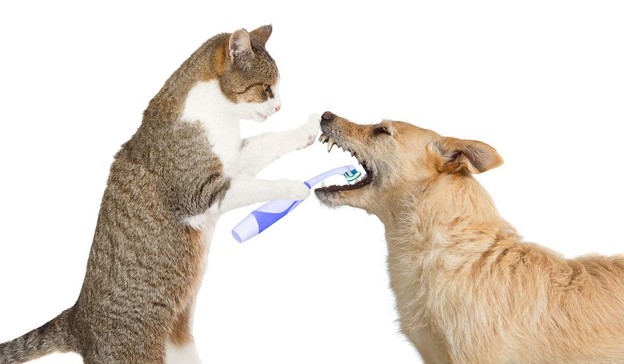IT’S JUST DOG AND CAT BREATH. WHAT’S ALL THE FUSS ABOUT?
Provided by Vetoquinol USA
Do you ever turn your nose up to your pet’s breath? Is it hard to sit next to them with the odor of their breath? Bad breath or halitosis is certainly not limited to humans and can affect dogs and cats. While humans are typically aware (or not aware) of halitosis our pets are oblivious when their breath smells atrocious. This poses a big problem as halitosis can be due to some major dental disease and we as owners are responsible for the oral health care of our pets.
What causes halitosis?
Halitosis is the result of odor-producing bacteria that build up in your pet’s mouth, lungs or gut. While we may think that the root of bad breath is always in the mouth, it could be a sign of a more major problem with the liver, kidneys or gastrointestinal tract. Regardless, halitosis is the result of bacteria build-up, saliva and food that have contributed to plaque. If left untreated, this build-up over time can result in an infection affecting the gums and surrounding tissues of the teeth and cause the breath to worsen.
What do I do if my pet has halitosis?
First, don’t panic! There are lots of remedies and help available. The best thing you can do is make an appointment with your veterinarian for a physical exam and comprehensive oral exam. He/she will recommend specific diagnostics based on physical exam findings and history. Blood work may be recommended to figure out if there is a problem present other than oral disease. If your veterinarian finds excessive calculus, broken teeth, discolored teeth, etc. on oral exam then he/she will recommend a dental cleaning under anesthesia.
What treatment will be done for my cat and dog with halitosis?
As mentioned previously, if there are problems found on the physical exam or blood work, then those problems will be addressed first. If a teeth cleaning is warranted and there are no problems on the initial exam or blood work, then a cleaning under anesthesia will be scheduled. Cleaning under anesthesia will typically begin with a thorough oral exam, dental radiographs, and routine scaling/polishing of all the teeth. The examination and radiographs may reveal more significant concerns that may require further treatment. If abnormalities are found, such as fractured teeth, tooth root abscesses, etc., then extraction of those teeth may be recommended. After the dental cleaning, sealants may be applied in some cases. Rinses, antibiotics, and pain medication may also be sent home to reduce discomfort, help clear infection, and allow for proper healing.
What can I do at home to help prevent/treat halitosis?
There are many easy things you can do at home to help prevent halitosis. There are lots of choices of toothpaste and toothbrushes designed specifically for pet use. Pets need their teeth brushed just like humans and it is recommended to brush them once a day. If that is too often for you, even as little as once a week will be beneficial. Antibacterial rinses can help with bacterial load and in turn with halitosis (and they are easier to use than they sound!). Chews can also be given to help with the mechanical removal of plaque. Some chews even contain antibacterial ingredients that can combat the bacterial load. Finally, some dental diets offer another option for removing plaque mechanically.
Remember to have a complete oral health exam performed at least annually as part of a general physical exam. Combining regular monitoring with proper dental care as recommended by your veterinarian will help to prevent halitosis and severe dental disease from occurring.
Call us at 727-222-5727 to make an appointment today!
References
- Manfra Marretta S: Periodontal Disease. Saunders Manual of Small Animal Practice 2nd Edition. Philadelphia: WB Saunders; 2000. p. 711-713.

